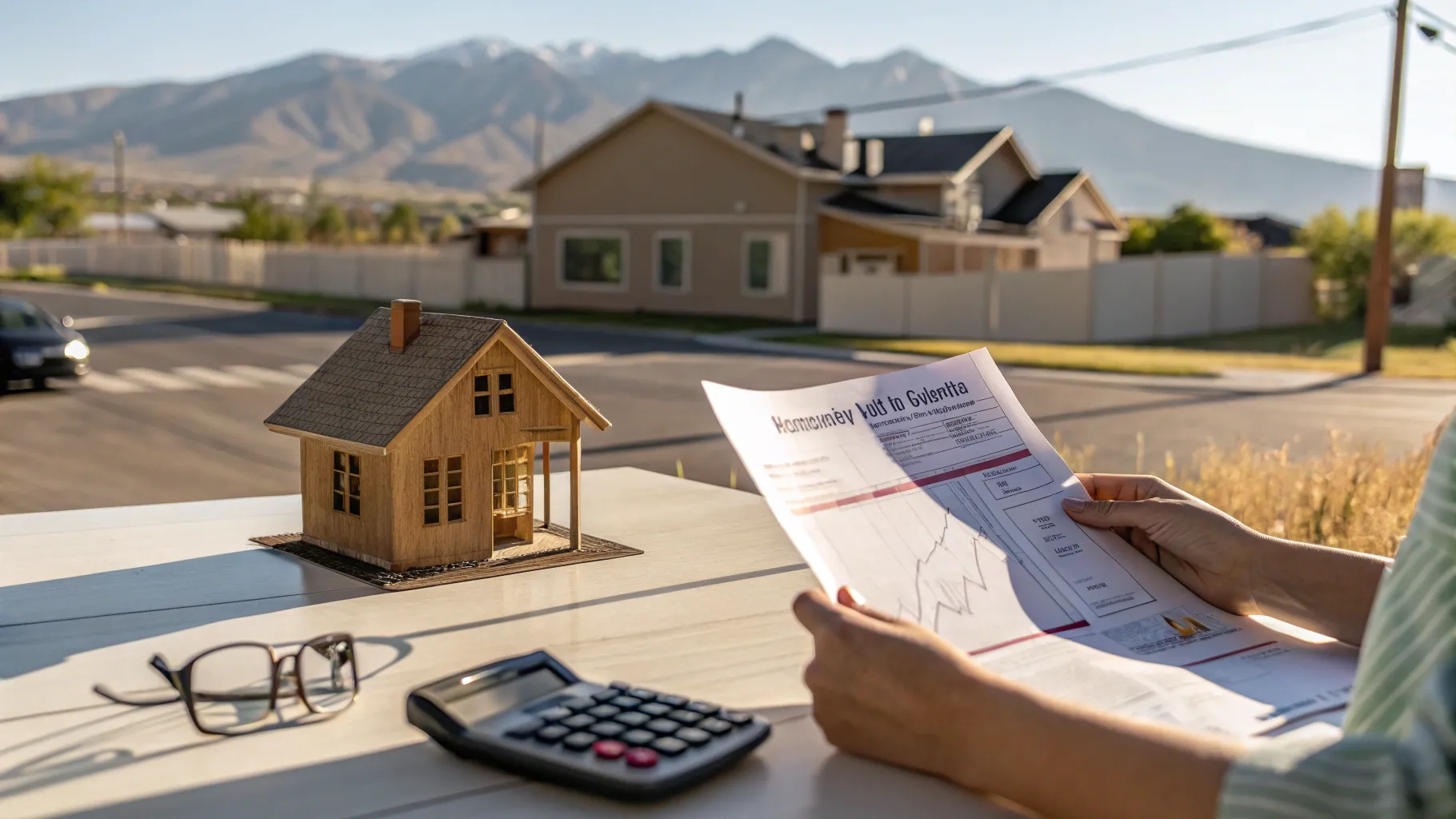
Property tax valuation notices for the upcoming tax year are arriving for Utah homeowners. These notices compare assessed home values from the prior tax year to the upcoming tax year and show estimated tax changes based on proposed county budgets. Homeowners should review these notices carefully: valuation changes do not always translate directly to tax decreases, and there are specific steps to take if an appeal is necessary.
Key takeaways at a glance
- Assessed values reflect estimated market value comparisons between the prior tax year and the upcoming tax year; lower market activity does not automatically mean lower taxes.
- Local trends can vary significantly within the same county — some neighborhoods may see assessed values and taxes rise while others decline.
- Homeowners should verify fundamental details on their notice, especially above-ground square footage and residency exemptions, before deciding whether to appeal.
Regional trends to watch in Salt Lake and surrounding counties
Recent assessments reveal a mixed picture across the Salt Lake region. In many neighborhoods on the east side of major corridors, assessed values appear higher, which can push taxes up if county budgets increase. In contrast, several west-side communities are seeing slight reductions in assessed values, resulting in modest tax decreases for some homeowners. Other counties present a patchwork: some make valuation data readily accessible online while others require more digging to obtain county forms and instructions.
How assessed values are calculated
County assessors estimate market value using available sales, property records, and parcel characteristics. Two critical elements to confirm on the notice are:
Explore Utah Real Estate

5618 E SOUTH FORK RD, Provo, UT
$43,000,000
Bedrooms: 6 Bathrooms: 10 Square feet: 22,958 sqft

864 W SAPPHIRE SKY LN #546, St George, UT
$4,300,000
Bedrooms: 7 Bathrooms: 9 Square feet: 5,136 sqft

1700 W 2700 N #36, Pleasant View, UT
$230,000
Bedrooms: 4 Bathrooms: 2 Square feet: 2,100 sqft
- Above-ground square footage: This number is commonly used in valuation models. Older homes are more likely to have measurement errors, so confirming the recorded square footage is essential. Overstated square footage can lead to an inflated assessed value and higher taxes.
- Residency exemption: Primary residences typically qualify for a resident exemption that substantially lowers taxable value. In many cases, this reduction is significant and directly affects the final tax bill.
Why a lower home value doesn't always mean lower taxes
Tax bills depend on two moving parts: assessed value and the tax rate set by local budgets. Even if a home's assessed value falls compared with the prior year, a county or local taxing entity could adopt a higher rate or approve a budget that increases taxes. Notices often display three figures: what was paid previously, what taxes would be under the proposed budget, and what taxes would be if budgets do not change. Homeowners should plan conservatively and assume proposed budget changes may be approved.
When and how to file an appeal
Homeowners who disagree with a property's assessed value can file an appeal with their county board of equalization. While exact procedures vary by county, the general expectations are consistent:
- Evidence required: Most counties request three to five comparable sales or a professional appraisal from the start of the tax year through the present. Comparable sales should be recent, like-for-like sales in the same neighborhood.
- Purchase records: Some counties allow submission of the home purchase contract or closing statement as supporting evidence, particularly when a recent arms-length purchase indicates a lower value than what appears on the notice.
- Where to submit: Appeals are typically filed with the county board of equalization. County assessor websites usually provide forms and filing instructions, though accessibility varies by county.
Important tip about comparables
Utah operates as a nondisclosure state for residential sale prices, meaning many national real estate portals may not show accurate sales data. For a credible appeal, homeowners should obtain official comparable sales from a real estate professional with access to the MLS. Public screenshots or listings from consumer websites usually will not meet evidentiary standards for an appeal.
More Properties You Might Like

850 LAZY WAY #8, Francis, UT
$1,300,000
Bedrooms: 4 Bathrooms: 4 Square feet: 2,755 sqft

La Casa Cir, St George, UT
$575,500
Square feet: 14,391 sqft

7665 STERLING DR, Park City, UT
$6,100,000
Bedrooms: 5 Bathrooms: 6 Square feet: 4,975 sqft
Practical checklist before filing an appeal
- Verify property details on the notice: square footage, lot size, number of bedrooms/bathrooms, and residency exemption status.
- Gather three to five recent comparable sales from the start of the tax year to the present, pulled from the MLS.
- If applicable, prepare the purchase contract or closing statement as additional proof of value.
- Locate the county board of equalization appeal form (search the county assessor site) and note filing deadlines and submission methods.
- Consider obtaining a professional appraisal if market conditions or unique property characteristics make comparables hard to find.
County differences and accessibility
Some counties make valuation data and appeal forms very easy to find on their official sites; others are more opaque and may require phone calls or a visit. Homeowners in counties with limited online access should call the assessor's office to confirm filing procedures and deadlines. When in doubt, requesting the appeal form directly from the county board can save time and prevent missed deadlines.
Conclusion
Property tax valuation notices merit careful review. Confirm the parcel details, verify the residency exemption, and understand that assessed value and tax rate both influence the final bill. If evidence suggests an assessed value is inaccurate, assemble solid MLS-based comparables or an appraisal and file an appeal with the county board of equalization. Proactive review and timely appeals can protect homeowners from overstated values and unexpected tax increases.
For additional local real estate resources, see https://bestutahrealestate.com. For state-level tax guidance and county links, visit utah.gov.
Frequently Asked Questions
How can a homeowner tell if the assessed square footage is wrong?
Compare the square footage listed on the notice with the measurement on the home’s deed, previous appraisal reports, or tax records. If discrepancies appear, request a measurement correction from the county assessor and provide supporting documents such as an appraisal or floor plan.
Are national real estate sites acceptable for appeal comparables?
No. Because of nondisclosure rules, national consumer sites often lack official sale price data for Utah. Comparable sales must be sourced from the MLS via a real estate professional or pulled from county-recorded sale documents where available.
What evidence is most persuasive in an appeal?
Recent comparable sales from the same neighborhood obtained from the MLS are typically the most persuasive. A licensed appraisal and recent purchase documentation can also carry significant weight.
What if the assessed value is accurate but taxes still increase?
Tax increases can occur when local budgets or tax rates rise. Even with a lower assessed value, a higher tax rate can increase the tax bill. Notices usually show taxes under the proposed budget and under an unchanged budget to help homeowners understand potential outcomes.
How many images or screenshots should be included with an appeal?
Relevant visual evidence can help, such as photos highlighting condition issues or discrepancies in square footage. However, the primary evidence should be documented comparables, appraisal reports, and official purchase records.














